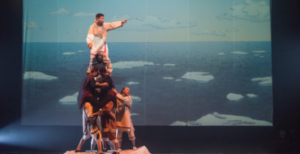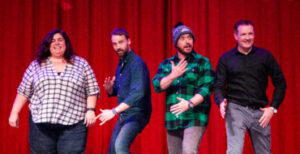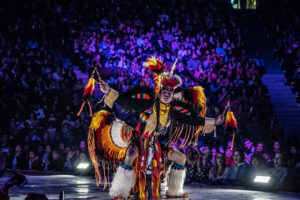Today ideas live and die on the power of their story. Experts agree that each and any business will owe its success— or indeed its failure— to the cultivation of three core concerns: build a great product, ensure affectionate relationships with customers and circulate the perfect story. While duties one and two are the prehistoric mainstays of trade, the third obligation is specific, if essential, to our age.
I learned this tidbit of wisdom Friday night at the fifth incarnation of Practivism, an annual design and communications event held at Science World and intent on inspiring positive social change in our time.
However, the first speaker Erica Priggen prefers the term ‘era.’ Executive producer of Free Range Studios, a DC/California-based marketing firm specializing in not-for-profit organizations, Priggen delineates the history of communication thusly… Following millennia upon millennia of oral culture, wherein thought and ideas spread over time and space from mouth to ear and mother to son, we were abruptly dialed into a phase of despotic Broadcast media. We remember this Godzilla-like presence from the freshly departed 20th century. Big publishing, big radio, big TV, big movie, big newspaper— in every single realm huge networks fashioned the means, colossal advertising agencies provisioned the message, and tiny consumers, shackled to couches and credit cards, paid money and mind for the messianic product. The voices we heard were given passage by the loudspeakers of the wealthy. But not to fear, Priggen assures, this era was merely an interrupter.
She brands the incipient 21st century ‘The Digitoral Era,’ the galloping rescuer of open talk and participatory media. Marshall McLuhan would have applauded. The grounding tenets of orality are back. Ideas are distributed, thoughts are enriched, voices are vivid and communication ever irradiates, right in front of our faces. Our curious fingers tap out a signal and Google tells us what we mean. Our #s and @s and Js bespeak not just our tastes, but also our hopes and fears. The Internet’s interminably looping feedback ensconces and enjoins us. And so now, as everyone uploads and shares his or her own narrative, what denouements direct each of us to click ‘like?’
Community. Sustainability. Responsibility—we thirst for the messages that embolden the charitable sections of our souls and enliven our civic-mindedness; we crave the heartfelt messages of empathy and evolution. Yet, though this magic tool can truly empower us to create this positive change, the trouble remains that with so much communication we must sweat to mine the meaningful messages from the mayhem… or else we just give up.
It is a speedy Darwinian struggle to be heard and, in turn, to inspire. Just as myth was passed down the oral tribe’s lineage, imparting morals and edifying culture, our stories swell and sway. McLuhan has alleged we live in something like a digitized tribe today. The strongest stories will survive. Priggen, a scholar of consciousness studies, explained the monomyth, or the hero’s journey. This theory, originated by Joseph Campbell, demonstrates a recurrent plot structure found in texts diverse as Greek mythology, The Bible, Tolkein’s novels and Star Wars. Beyond the departure, the initiation and the return, the key is remembering that the audience is the hero and the storyteller is the mentor. This reversal of the widely felt wish for self-exaltation, be it a savvy marketing move or not, is a step toward the necessary common duties of education and service.
In the storyline of my night, the next guru to take the stage was Lorne Craig, creative director of Vancouver-based Unicycle Creative. His company uses design and stories to help move environmental and socially-sustainable businesses forward. He says the name represents ever-present cycles (not unlike those suggested by Campbell) and the goal of leaving the single slimmest environmental footprint (not unlike that produced by a mono-wheeled bicycle). Craig has lent his hand to eco-friendly small business owners, advised on green initiatives by larger companies, convinced whole communities to go for a walk and designed print material for The Green Party of Canada. His website advises, “brand or die.”
Free Range Studios suggests that every individual, let alone business, ought to foster his or her own brand. Come not with a resume, but with a story in hand. Priggen’s company, owned by her childhood friends, has helped spread important messages and each began with a powerful narrative. “The Story of Stuff,” a video describing the ascent of materialism, the buildup of waste and the need for reform, spawned a series of spin-off “the story ofs.” Free Range also led a campaign encouraging citizens to contribute to the rebuild efforts following Hurricane Sandy. The video Priggen helped disseminate presented everyday folks with that crucial opportunity for heroism.
My night was very enlightening. I spoke with many young web designers and budding communications specialists, all resolved to make the world a more sustainable and egalitarian place. Two of them walked away with scholarships. But we don’t all need to be web designers to help with the cause. And we don’t need money. The Internet, that pervasive and persuasive instrument, provides us each with a mirror, a magnifying glass, a telescope and a podium. En masse we are a multitude of knowledgeable messengers, be it wittingly or not. And now we have the chance and charge to embody those sorts of stories that can lead to positive change.









